Results 61 to 70 of 97
-
06-02-2006, 01:49 PM #61C.I.A.

- Join Date
- Jul 2004
- Posts
- 7,924
-
06-02-2006, 06:52 PM #62
 Re: The Lies and Prejudices of ANTI-Catholics
I know. But I do. I care whether they are being deceived or not. I guess you don't.
Re: The Lies and Prejudices of ANTI-Catholics
I know. But I do. I care whether they are being deceived or not. I guess you don't. Originally Posted by weedmeister2
Originally Posted by weedmeister2
And Jesus did NOT teach the fundamental protestant principles of sola scriptura or sola fide. Kindly show me where Jersus taught these. There's not a single verse in the Bible that states the Bible is the SOLE source of Christian doctrine. Not a single verse! What Jesus taught then, however, is now taught by the Catholic Church, not your false church.But the fact is, calling me names will not change the teachings of Jesus.
If you believe in the principles of sola scriptura and sola fide, and if you believe the canon of the Bible shouild not incluide the deuterocanonical books (which Luther called "apocrypha"), then you actually rely on Martin Luther more than you know.I do not rely on Martin Luther.
Where do you think sola scriptuira and sola fide came from? These were NOT believed by the early Christians. There is absolutely no historical record whatsover showing that they did so. These fundamental protestant principles aren't in the Bibnle and they were not taught by the early Christian fathers. They were MADE UP BY LUTHER. And Luther cut out the deuterocanonical books from his biblical canon (and even some books for the New Testament as well!). But your church believes in his lies.
Bwahahaha! What IGNORANCE. Haven't you even considered that killing that many people would have depopulated Europe, especially Spain, where the worst Inquisition was generally considered to have taken place? Your numbers are so exagerated they are plain ridiculous!Inquisition: 6,000,000 to 9,000,000 dead
Recent historical stuides have gone beyond the legends and the ;latest figures show that the number of thoser killed during the Spanish Inquisition were only around 2000-4000. That's not good, but that is NOWHERE NEAR THE RIDICULOUS NUMBERS YOU CLAIM!
From: http://www.catholic.com/library/Inquisition.asp
Inquisitions did not exist in Northern Europe, Eastern Europe, Scandinavia, or England, being confined mainly to
southern France, Italy, Spain, and a few parts of the Holy Roman Empire. The Inquisition could not have killed
that many people because those parts of Europe did not have that many people to kill!
Furthermore, the plague, which killed a third of Europeâs population, is credited by historians with major changes
in the social structure. The Inquisition is credited with fewâprecisely because the number of its victims was
comparitively small. In fact, recent studies indicate that at most there were only a few thousand capital sentences
carried out for heresy in Spain, and these were over the course of several centuries.
And your protestant heritage has more blood on its hands too, as seen below (same source):
... Luther and Calvin both endorsed the right of the state to protect society by purging false religion. In fact,
Calvin not only banished from Geneva those who did not share his views, he permitted and in some cases ordered
others to be executed for "heresy" (e.g. Jacques Gouet, tortured and beheaded in 1547; and Michael Servetus,
burned at the stake in 1553). In England and Ireland, Reformers engaged in their own ruthless inquisitions and
executions. Conservative estimates indicate that thousands of English and Irish Catholics were put to death -- many
by being hanged, drawn, and quartered -- for practicing the Catholic faith and refusing to become Protestant. An
even greater number were forced to flee to the Continent for their safety. We point this out to show that the
situation was a two-way street; and both sides easily understood the Bible to require the use of penal sanctions to
root out false religion from Christian society.
The fact that the Protestant Reformers also created inquisitions to root out Catholics and others who did not fall into
line with the doctrines of the local Protestant sect shows that the existence of an inquisition does not prove that a
movement is not of God. Protestants cannot make this claim against Catholics without having it backfire on themselves.
Neither can Catholics make such a charge against Protestants. The truth of a particular system of belief must be decided
on other grounds.
Another gross exaggeration. By the way, without the crusades you may not even have Christianity today, or at leatst much more of the world wouldn't be Christian. I guess you would be proud of that.Crusades: up to 7,000,000
In case you didn't know, the Crusades were DEFENSIVE. They were not meant toi expand Christendom. They were a defnese against the aggression carried out by Islamic expansionism. Christian Europe could hardly have hoped to attack and conquer Islam. It was too weak. Islam was the dominant "suoerpower" at that time. But the Crusades could (and did for a while) defend the Christian territories that were being invaded by Islamic armies. See below:
Crusades
http://www.newadvent.org/cathen/04543c.htm
From the outset the Crusades were defensive wars and checked the advance of the Mohammedans who,
for two centuries, concentrated their forces in a struggle against the Christian settlements in Syria; hence
Europe is largely indebted to the Crusades for the maintenance of its independence.
Killed by who? In case you forgot, the Catholic Church saved more Jews than any country. And certainly more than the "born again" churches who ignored the holocaust and did NOTHING.Holocaust: 9,000,000 to 11,000,000
More like over 200!On the matter of the popes, I guess you're right, God would have settled for 4 out of 5 good Vicars of Christ...
You seem to have this icnredible knack for getting the numbers wrong. If you're going to argue about history, you should at least get some of your important facts straight! But then that is one of the more noticeable effects of prejudice: disregard for the truth. How very Christian of you.
-
06-02-2006, 07:06 PM #63
 Re: The Lies and Prejudices of ANTI-Catholics
Re: The Lies and Prejudices of ANTI-Catholics
Weedmeister, after all these arguments, it seems clear that you have totally FAILED to establish any of your claims agaianst the Church.
- You claim that papal infallibility was a new doctrine because there was disagreement at Vatican I. But I showed there was much disagreement at Nicaea too, the council that formally defined the divinity of Christ. If we follow your logic, then the divinity of Christ was a recent, "made up" doctrine as well. ABSURD!
- You claim that mariolatry exists in the Church because we exalt her as above all creatures, and therefore as being above the Holy Trinity as well. But that mindless claim only works of the Trinity, and the Person of the Trinity, are mere creatures. But the Persons in the Trinity are NOT creatures. And so your claim falls flat on its face.
- You claim papal infallibility cannot be true because certain popes made errors. But that involves a misrepresentation of the doctrine of papal infallibility. The doctrine, as I have expalined REPEATEDLY, only comes into force when the popes make an ex cathedra statement. And I have shown that in ALL the instances where you claim the popes made a mistake, they were NOT making ex cahtewdra statements. So all your claims here fail as well.
- You also make fantastic claims about the victims of the Inquisition. Your numbers are so obviously exaggeredt they are ridiculous!
- And you try to oin the holocaust on the Church, when in fact the Catholic Church saved the most Jews (while your born-again churches did NOTHING).
So, I think we have made the point of this thread! It exposes the LIES and PREJUDICES of anti-Catholics like yourself. Perhaps you would like to peddle more silly claims so I can continue to expose more of your deceptions? :mrgreen:
- You claim that papal infallibility was a new doctrine because there was disagreement at Vatican I. But I showed there was much disagreement at Nicaea too, the council that formally defined the divinity of Christ. If we follow your logic, then the divinity of Christ was a recent, "made up" doctrine as well. ABSURD!
-
06-02-2006, 08:05 PM #64
 Re: The Lies and Prejudices of ANTI-Catholics
Re: The Lies and Prejudices of ANTI-Catholics
The Inquisition
http://www.catholic.com/library/inquisition.asp
Sooner or later, any discussion of apologetics with Fundamentalists will address the Inquisition. To non-Catholics it is a scandal; to Catholics, an embarrassment; to both, a confusion. It is a handy stick for Catholic-bashing, simply because most Catholics seem at a loss for a sensible reply. This tract will set the record straight.
There have actually been several different inquisitions. The first was established in 1184 in southern France as a response to the Catharist heresy. This was known as the Medieval Inquisition, and it was phased out as Catharism disappeared.
Quite separate was the Roman Inquisition, begun in 1542. It was the least active and most benign of the three variations.
Separate again was the infamous Spanish Inquisition, started in 1478, a state institution used to identify conversosâJews and Moors (Muslims) who pretended to convert to Christianity for purposes of political or social advantage and secretly practiced their former religion. More importantly, its job was also to clear the good names of many people who were falsely accused of being heretics. It was the Spanish Inquisition that, at least in the popular imagination, had the worst record of fulfilling these duties.
The various inquisitions stretched through the better part of a millennia, and can collectively be called "the Inquisition."
The Main Sources
Fundamentalists writing about the Inquisition rely on books by Henry C. Lea (1825â1909) and G. G. Coulton (1858â1947). Each man got most of the facts right, and each made progress in basic research, so proper credit should not be denied them. The problem is that they did not weigh facts well, because they harbored fierce animosity toward the Churchâanimosity that had little to do with the Inquisition itself.
The contrary problem has not been unknown. A few Catholic writers, particularly those less interested in digging for truth than in diffusing a criticism of the Church, have glossed over incontrovertible facts and tried to whitewash the Inquisition. This is as much a disservice to the truth as an exaggeration of the Inquisitionâs bad points. These well-intentioned, but misguided, apologists are, in one respect, much like Lea, Coulton, and contemporary Fundamentalist writers. They fear, while the others hope, that the facts about the Inquisition might prove the illegitimacy of the Catholic Church.
Donât Fear the Facts
But the facts fail to do that. The Church has nothing to fear from the truth. No account of foolishness, misguided zeal, or cruelty by Catholics can undo the divine foundation of the Church, though, admittedly, these things are stumbling blocks to Catholics and non-Catholics alike.
What must be grasped is that the Church contains within itself all sorts of sinners and knaves, and some of them obtain positions of responsibility. Paul and Christ himself warned us that there would be a few ravenous wolves among Church leaders (Acts 20:29; Matt. 7:15).
Fundamentalists suffer from the mistaken notion that the Church includes only the elect. For them, sinners are outside the doors. Locate sinners, and you locate another place where the Church is not.
Thinking that Fundamentalists might have a point in their attacks on the Inquisition, Catholics tend to be defensive. This is the wrong attitude; rather, we should learn what really happened, understand events in light of the times, and then explain to anti-Catholics why the sorry tale does not prove what they think it proves.
Phony Statistics
Many Fundamentalists believe, for instance, that more people died under the Inquisition than in any war or plague; but in this they rely on phony "statistics" generated by one-upmanship among anti-Catholics, each of whom, it seems, tries to come up with the largest number of casualties.
But trying to straighten out such historical confusions can take one only so far. As Ronald Knox put it, we should be cautious, "lest we should wander interminably in a wilderness of comparative atrocity statistics." In fact, no one knows exactly how many people perished through the various Inquisitions. We can determine for certain, though, one thing about numbers given by Fundamentalists: They are far too large. One book popular with Fundamentalists claims that 95 million people died under the Inquisition.
The figure is so grotesquely off that one immediately doubts the writerâs sanity, or at least his grasp of demographics. Not until modern times did the population of those countries where the Inquisitions existed approach 95 million.
Inquisitions did not exist in Northern Europe, Eastern Europe, Scandinavia, or England, being confined mainly to southern France, Italy, Spain, and a few parts of the Holy Roman Empire. The Inquisition could not have killed that many people because those parts of Europe did not have that many people to kill!
Furthermore, the plague, which killed a third of Europeâs population, is credited by historians with major changes in the social structure. The Inquisition is credited with fewâprecisely because the number of its victims was comparitively small. In fact, recent studies indicate that at most there were only a few thousand capital sentences carried out for heresy in Spain, and these were over the course of several centuries.
Whatâs the Point?
Ultimately, it may be a waste of time arguing about statistics. Instead, ask Fundamentalists just what they think the existence of the Inquisition demonstrates. They would not bring it up in the first place unless they thought it proves something about the Catholic Church. And what is that something? That Catholics are sinners? Guilty as charged. That at times people in positions of authority have used poor judgment? Ditto. That otherwise good Catholics, afire with zeal, sometimes lose their balance? All true, but such charges could be made even if the Inquisition had never existed and perhaps could be made of some Fundamentalists.
Fundamentalist writers claim the existence of the Inquisition proves the Catholic Church could not be the Church founded by our Lord. They use the Inquisition as a goodâperhaps their bestâbad example. They think this shows that the Catholic Church is illegitimate. At first blush it might seem so, but there is only so much mileage in a ploy like that; most people see at once that the argument is weak. One reason Fundamentalists talk about the Inquisition is that they take it as a personal attack, imagining it was established to eliminate (yes, you guessed it) the Fundamentalists themselves.
Not "Bible Christians"
They identify themselves with the Catharists (also known as the Albigensians), or perhaps it is better to say they identify the Catharists with themselves. They think the Catharists were twelfth-century Fundamentalists and that Catholics did to them what they would do to Fundamentalists today if they had the political strength they once had.
This is a fantasy. Fundamentalist writers take one pointâthat Catharists used a vernacular version of the Bibleâand conclude from it that these people were "Bible Christians." In fact, theirs was a curious religion that apparently (no one knows for certain) came to France from what is now Bulgaria. Catharism was a blend of Gnosticism, which claimed to have access to a secret source of religious knowledge, and of Manichaeism, which said matter is evil. The Catharists believed in two gods: the "good" God of the New Testament, who sent Jesus to save our souls from being trapped in matter; and the "evil" God of the Old Testament, who created the material world in the first place. The Catharistsâ beliefs entailed seriousâtruly civilization-destroyingâsocial consequences.
Marriage was scorned because it legitimized sexual relations, which Catharists identified as the Original Sin. But fornication was permitted because it was temporary, secret, and was not generally approved of; while marriage was permanent, open, and publicly sanctioned.
The ramifications of such theories are not hard to imagine. In addition, ritualistic suicide was encouraged (those who would not take their own lives were frequently "helped" along), and Catharists refused to take oaths, which, in a feudal society, meant they opposed all governmental authority. Thus, Catharism was both a moral and a political danger.
Even Lea, so strongly opposed to the Catholic Church, admitted: "The cause of orthodoxy was the cause of progress and civilization. Had Catharism become dominant, or even had it been allowed to exist on equal terms, its influence could not have failed to become disastrous." Whatever else might be said about Catharism, it was certainly not the same as modern Fundamentalism, and Fundamentalist sympathy for this destructive belief system is sadly misplaced.
The Real Point
Many discussions about the Inquisition get bogged down in numbers and many Catholics fail to understand what Fundamentalists are really driving at. As a result, Catholics restrict themselves to secondary matters. Instead, they should force the Fundamentalists to say explicitly what they are trying to prove.
However, there is a certain utilityâthough a decidedly limited oneâin demonstrating that the kinds and degrees of punishments inflicted by the Spanish Inquisition were similar to (actually, even lighter than) those meted out by secular courts. It is equally true that, despite what we consider the Spanish Inquisitionâs lamentable procedures, many people preferred to have their cases tried by ecclesiastical courts because the secular courts had even fewer safeguards. In fact, historians have found records of people blaspheming in secular courts of the period so they could have their case transferred to an ecclesiastical court, where they would get a better hearing.
The crucial thing for Catholics, once they have obtained some appreciation of the history of the Inquisition, is to explain how such an institution could have been associated with a divinely established Church and why it is not proper to conclude, from the existence of the Inquisition, that the Catholic Church is not the Church of Christ. This is the real point at issue, and this is where any discussion should focus.
To that end, it is helpful to point out that it is easy to see how those who led the Inquisitions could think their actions were justified. The Bible itself records instances where God commanded that formal, legal inquiriesâthat is, inquisitionsâbe carried out to expose secret believers in false religions. In Deuteronomy 17:2â5 God said: "If there is found among you, within any of your towns which the Lord your God gives you, a man or woman who does what is evil in the sight of the Lord your God, in transgressing his covenant, and has gone and served other gods and worshiped them, or the sun or the moon or any of the host of heaven, which I have forbidden, and it is told you and you hear of it; then you shall inquire diligently [note that phrase: "inquire diligently"], and if it is true and certain that such an abominable thing has been done in Israel, then you shall bring forth to your gates that man or woman who has done this evil thing, and you shall stone that man or woman to death with stones."
It is clear that there were some Israelites who posed as believers in and keepers of the covenant with Yahweh, while inwardly they did not believe and secretly practiced false religions, and even tried to spread them (cf. Deut. 13:6â11). To protect the kingdom from such hidden heresy, these secret practitioners of false religions had to be rooted out and expelled from the community. This directive from the Lord applied even to whole cities that turned away from the true religion (Deut. 13:12â1 . Like Israel, medieval Europe was a society of Christian kingdoms that were formally consecrated to the Lord Jesus Christ. It is therefore quite understandable that these Catholics would read their Bibles and conclude that for the good of their Christian society they, like the Israelites before them, "must purge the evil from the midst of you" (Deut. 13:5, 17:7, 12). Paul repeats this principle in 1 Corinthians 5:13.
. Like Israel, medieval Europe was a society of Christian kingdoms that were formally consecrated to the Lord Jesus Christ. It is therefore quite understandable that these Catholics would read their Bibles and conclude that for the good of their Christian society they, like the Israelites before them, "must purge the evil from the midst of you" (Deut. 13:5, 17:7, 12). Paul repeats this principle in 1 Corinthians 5:13.
These same texts were interpreted similarly by the first Protestants, who also tried to root out and punish those they regarded as heretics. Luther and Calvin both endorsed the right of the state to protect society by purging false religion. In fact, Calvin not only banished from Geneva those who did not share his views, he permitted and in some cases ordered others to be executed for "heresy" (e.g. Jacques Gouet, tortured and beheaded in 1547; and Michael Servetus, burned at the stake in 1553). In England and Ireland, Reformers engaged in their own ruthless inquisitions and executions. Conservative estimates indicate that thousands of English and Irish Catholics were put to deathâmany by being hanged, drawn, and quarteredâfor practicing the Catholic faith and refusing to become Protestant. An even greater number were forced to flee to the Continent for their safety. We point this out to show that the situation was a two-way street; and both sides easily understood the Bible to require the use of penal sanctions to root out false religion from Christian society.
The fact that the Protestant Reformers also created inquisitions to root out Catholics and others who did not fall into line with the doctrines of the local Protestant sect shows that the existence of an inquisition does not prove that a movement is not of God. Protestants cannot make this claim against Catholics without having it backfire on themselves. Neither can Catholics make such a charge against Protestants. The truth of a particular system of belief must be decided on other grounds.
-
06-02-2006, 08:28 PM #65
 Re: The Lies and Prejudices of ANTI-Catholics
Re: The Lies and Prejudices of ANTI-Catholics
hehehe, the fact that you base ALL your claims and info on Catholic sources makes it all MOOT and ACADEMIC.

-
06-02-2006, 08:31 PM #66
 Re: The Lies and Prejudices of ANTI-Catholics
mao lagi bro oi...pasta labara na jud sa ako ulo ani....unsaon sila ra man gud ang TRUE religion...so of course theirs is the only book of truth...
Re: The Lies and Prejudices of ANTI-Catholics
mao lagi bro oi...pasta labara na jud sa ako ulo ani....unsaon sila ra man gud ang TRUE religion...so of course theirs is the only book of truth... Originally Posted by weedmeister2
Originally Posted by weedmeister2

-
06-03-2006, 09:29 AM #67
 Re: The Lies and Prejudices of ANTI-Catholics
Re: The Lies and Prejudices of ANTI-Catholics
mao jud sis...
Sige na lang oi, TOTAL FAILURE na lang ko oi...
Kita kita na lang ta sa Langit or Impyerno bai... In the meantime.... RAKENROLL!Â* :mrgreen:
hehehe, here's manny's philosophy:
"Bottom line: When buying books on religious and spiritual matters, seek out those books written before Vatican II and which have the "Imprimatur," or those books which are known to be written by solidly orthodox traditional Catholics. Otherwise, be wary and take the book with a grain of salt. And, always, if you come across a book that says horrific things about the Church, Her teachings, or Her history, read the traditional Catholic point of view and dig up objective resources. There's a lot of lying going on out there, folks."
http://www.fisheaters.com/imprimatur.html
you were taught that, weren't you...? No reading unless it has "IMPRIMATUR" or "NIHIL OBSTAT"... hehehe, i was brainwashed in much the same way, manny... don't worry, you can open your eyes now... :mrgreen:
-
06-03-2006, 10:12 AM #68
 Re: The Lies and Prejudices of ANTI-Catholics
Re: The Lies and Prejudices of ANTI-Catholics
hmmmm, pwede debate through pictures na lang bai?? pictures are more accurate man gud... dili ka ka ingon na "YOU LIAR!" kay naa may ebidensiya... even if your catholic books (written by biased catholic spin doctors) say one thing, pictures will definitely tell the truth, unless they were photoshopped... hehehe
Here is your truth:
And you try to oin the holocaust on the Church, when in fact the Catholic Church saved the most Jews
And to back up your claim, here are pictures of the Catholics going against the atrocities and condemning the massacres:
In 1933 the Vatican signed a Concordat with Germany making Roman Catholicism the only recognized religion in that country.
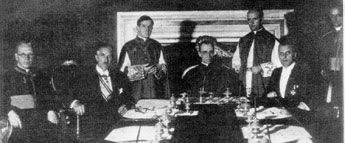
Signing the Concordat is Cardinal Pacelli (later to become Pope Pius XII). By 1933, he was the Vatican Secretary of State. Seated second from his left is Franz von Papen who was the Papal Nuncio to Germany. Standing at the far right can be seen the little known Vatican prelate, Montini, later to become Pope Paul VI.
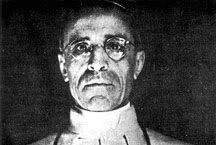
Eugenio Pacelli (Pope Pius XII from 1939 to 195 was a brilliant diplomat, a cunning politician and a religious crusader. He was appointed Papal Nuncio to Germany in 1920 â the first since the Reformation!! He, more than anybody else outside Germany, helped Hitler to power.
was a brilliant diplomat, a cunning politician and a religious crusader. He was appointed Papal Nuncio to Germany in 1920 â the first since the Reformation!! He, more than anybody else outside Germany, helped Hitler to power.

Archbishop Cesare Orsenigo, papal nuncio to Germany, talks with Hitler at a formal reception in Berlin in Jan. 1936.

Hitler greets Msgr. Joseph Tiso, Slovakian Chief of State, Papal Chamberlain and Roman Catholic priest, at Hitler's field headquarters on the Eastern Front, October, 1941.
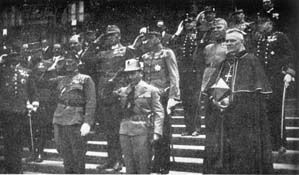
Little Dollfuss (Dictator of Austria) with Cardinal Innitzer on the right, witnessing the proclamation of the new Clerical-Fascist Constitution in 1934.

Dr. Schuschnigg, Price Staremberg and Cardinal Innitzer with Dollfuss.
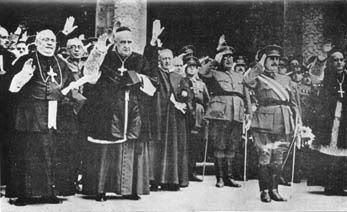
The Spanish Catholic Hierarchy giving the Fascist salute at Santiago de Compostela in 1937.
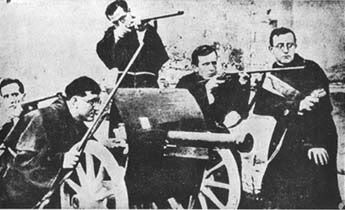
Catholic "evangelization" during the Spanish Civil War.Â* Â*:mrgreen:

Catholic clergy and Nazi officials, including Joseph Goebbels (far right) and Wilhelm Frick (second from right), give the Nazi salute.

Priests give Hitler salute at a Catholic youth rally in the Berlin-Neukolln stadium.

Croatian Catholic Cardinal Stepinac, front center, was a deputy in the Sabor, the pseudo-legislature of the Nazi-like Croatian Ustashi dictatorship.Â*
[img width=500 height=412]http://emperor.vwh.net/images/ustashe.jpg[/img]
Croatian Ustashi fuehrer Ante Pavelic giving Nazi salute (far left) with Archbishop Alojzije Stepinac (far right) and other Catholic Church leaders

A Cardinal marches with the German Nazis.

Croatian Ustashi dictator Ante Pavelic with Franciscan monks.Â* The Franciscan order was active in the genocide against Serbs andÂ* Jews.
-
06-03-2006, 10:38 AM #69
-
06-03-2006, 10:57 AM #70Junior Member

- Join Date
- Oct 2004
- Posts
- 258
 Re: The Lies and Prejudices of ANTI-Catholics
Re: The Lies and Prejudices of ANTI-Catholics
hala! murag katuhuan kaayo (dili si bert ha)! to see is to believe.
but I know how to get around with it.
"blessed are those who have seen but did not believe".
Advertisement
Similar Threads |
|










